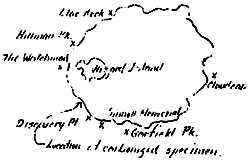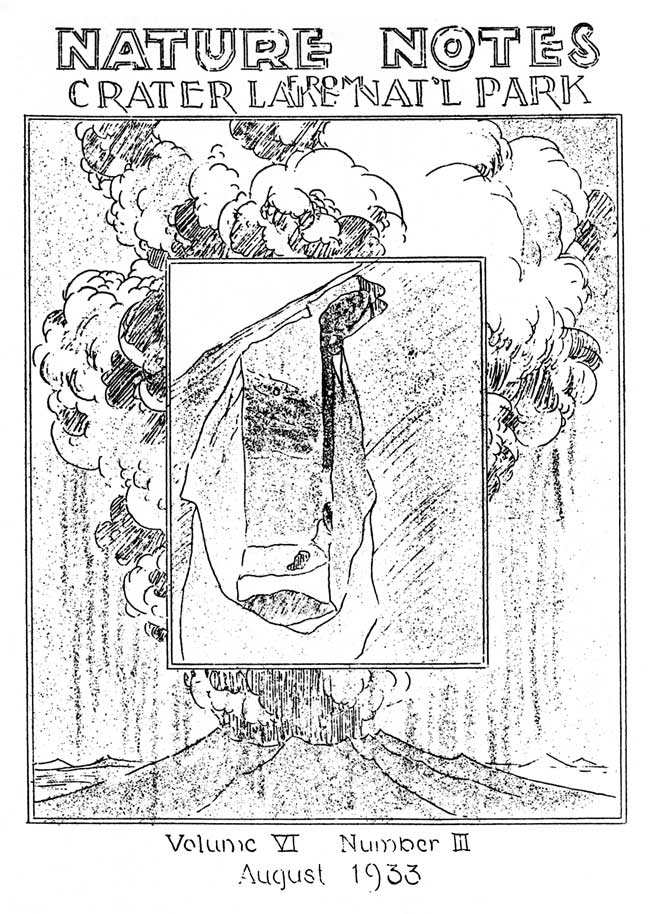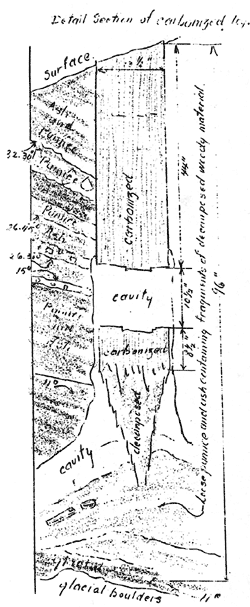Volume 6 No. 3 – August 1, 1933
All material courtesy of the National Park Service.These publications can also be found at http://npshistory.com/
Nature Notes is produced by the National Park Service. © 1933
An Indian Giver
By Ranger R. P. Andrews
(Online Edition Note: Of the hundreds of excellent and informative articles published in Nature Notes, the following article is not one of them. Our apologies for the insenitive nature of this article.)
One hot day some time ago an old model T Ford rattled down the hill from the west and with a wheeze and sigh expired in front of the Annie Springs station. It was a motley menage indeed. The running boards, top, fenders, – in fact every available space was piled high with gear. Wedged into the back seat were two Indian children and an old woman who appeared a hundred years old, at least. But what attracted my attention especially was the driver. He was an Indian of middle age, dirty and unkempt. Such sights are common at Annie Springs and one might be led to wonder why it attracted my attention. However, one who has checked through hundreds of impassive faced Klamaths would indeed be impassive himself were he not startled by that rarest of all Indian facial expressions – a smile. I approached the still steaming remains of what had once been an automobile. Permit book in hand, I inquired his name.
I will not detail the conversation that followed, but I found the driver jovial, friendly, and enthusiastic about the roads and the scenery.
Finally, after obtaining the required information, I tore off the permit and said, “The permit is one dollar”.
He swept an all embracive arm from east to wet. “One time”, he said with regret but no malice, “all this belonged to Indians, Indians hunted, fished, and traveled this country. It was Indian’s land. Then white man came. He cooped Indian up on reservation”. He sighed. “Now white man charges Indian one dollar to travel his own country”.
His words seemed to carry no conviction. He was not in earnest. He seemed to be repeating his tribe’s old, old objection, just to see what I would say. I decided to “kid” him a little.
I assumed a lugubrious expression. “One time Indian had no way to travel. Poor Indian had sore feet”. Here my expression brightened. “Then white man came. Now Indian has no more sore feet. White man took Lake – gave Indian Ford”.
Immediately he chuckled. “OK”, he laughed, handing me the dollar and releasing the hand brake. “You keep Lake – Indian take ’em Ford”. And he rattled off as I stood staring after the strangest of all anomalies – an Irish personality in an Indian body – a smart-cracking Hiawatha.
Carbonized Tree Found Within the Rim
By Park Naturalist D. S. Libbey
One of the most significant discoveries that has been made since Crater Lake has been known to white men was made on August 1. A carbonized tree trunk in upright position was discovered within the rim of Crater Lake by Ranger – Naturalist Albert E. Long while he was assigned to research study. On August 7 Mr. Long in company with the writer uncovered the specimen. A complete photographic record of the find was taken, pictures being taken prior to any excavation, and at the significant stages in the progress of unearthing the specimen. The sketch below indicates the location of the find within the rim of the crater.
Only a very small portion of the specimen was exposed. The log as unearthed was 13-1/2 inches in diameter at the top and 15-1/2 at the base and stood in an almost upright position, leaning six degrees to the north. The excavation of the find was only partially completed so that only one side of the log was exposed, revealing the positive evidence of the in situ character of the find.
By reference to the accompanying diagram it will be seen that the total length of the log was 52 inches. It is evident that the stump and bole of the tree was the portion found. The lower section, including the huge branching roots, was not carbonized, and large cavities resulted from the disintegration and decomposition of the roots and stump. The entire section was as follows: 44 inches from the top completely carbonized, then a break occurred with a cavity 10-1/2 inches resulting from the slipping of the lower section. The lower portion of the stump and roots decomposed and the cavity resulted.
Below the break 8-1/2 inches of carbonized log was found which graded into the uncarbonized material which progressively became more decomposed until finally the huge open space was found, which resulted from the decomposition of the uncarbonized stump and roots.
The roots now decomposed were originally imbedded in a layer of glacial debris, (mixed rocks, and ash and glacial clays resulting from the breaking down of andesite rocks). This bedded material was dipping at an angle of 11 degrees to the west. The layers on top rest in various attitudes. The layers in sequence from the base up were found to repose at attitudes of 11 degrees, 15 degrees, 26 degrees 15 minutes, 26 degrees 45 minutes, and 30 degrees 30 minutes.
The roots and stump rested on a mass of heterogeneous glacial debris. The bole of the tree just above the glacial imbedded stump and roots was surrounded with pumice and pumicite material which evidently fell and tumbled down the slope after it was cool and hence the lower portion was not carbonized.
The carbonized portion was imbedded in angular pumice fragments interspersed with pumice dust and ash material. The inner facing crest of the rim above the location of this discovery consists of an overburden of slightly sorted glacial debris, intermingled with pumicite.
In 1931 the writer published in Crater Lake Nature Notes (Vol. IV, No. 1) an article titled “Carbonized Wood – An Index to the Past”, which reported the discovery of huge carbonized logs in the excavation along the new Diamond Lake Highway, still under construction. A cross-section of a huge log was obtained by the writer during July, 1931 and was placed in the museum room of the Sinnott Memorial where it now rests. On July 27 of this year in company with Mr. John R. Sargent, Resident Engineer for the Bureau of Public Roads, the writer obtained another cross-section of a carbonized log from the Diamond Lake Highway excavation approximately ten miles above the place where the 1931 specimen was taken. It is planned to place this specimen in the museum room of the Watchman Observation Station with a marker pointing to the place from which the find was taken. The specimen was found just to the east of the Rabbit Ears, 20 miles to the west of the rim of Crater Lake, 25 feet above and 100 yards from the stream course of the Rogue River.




